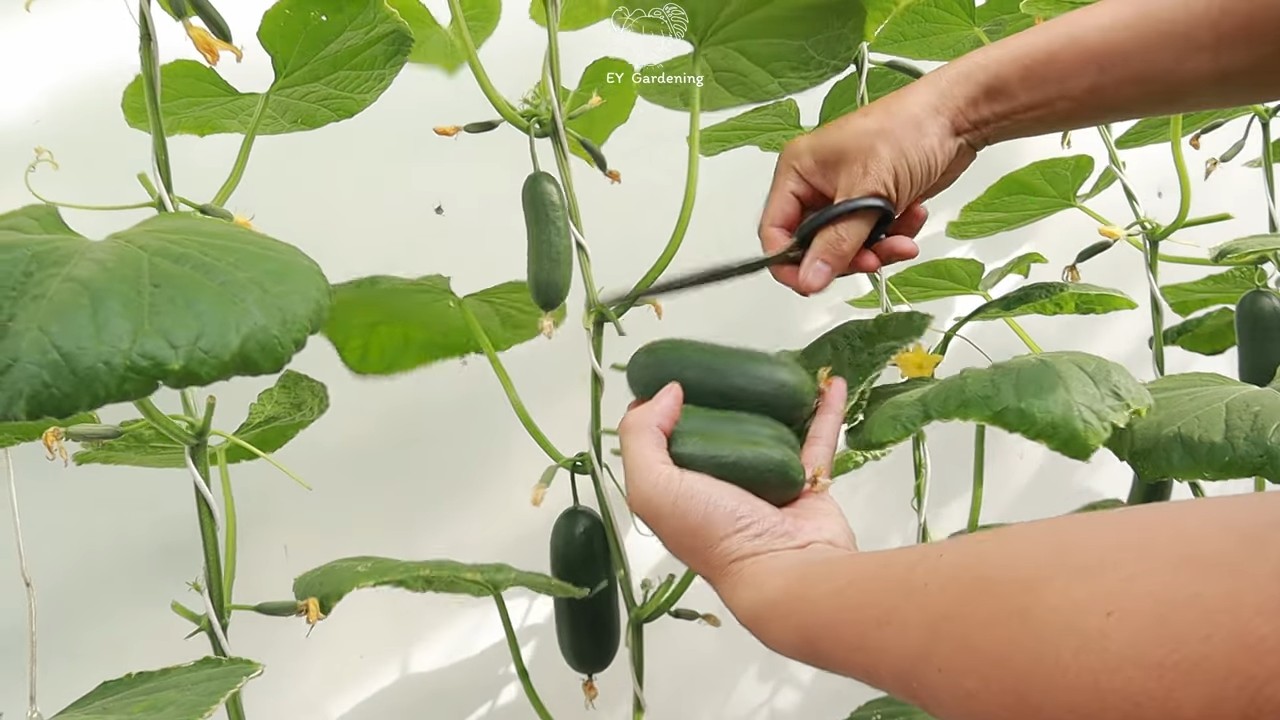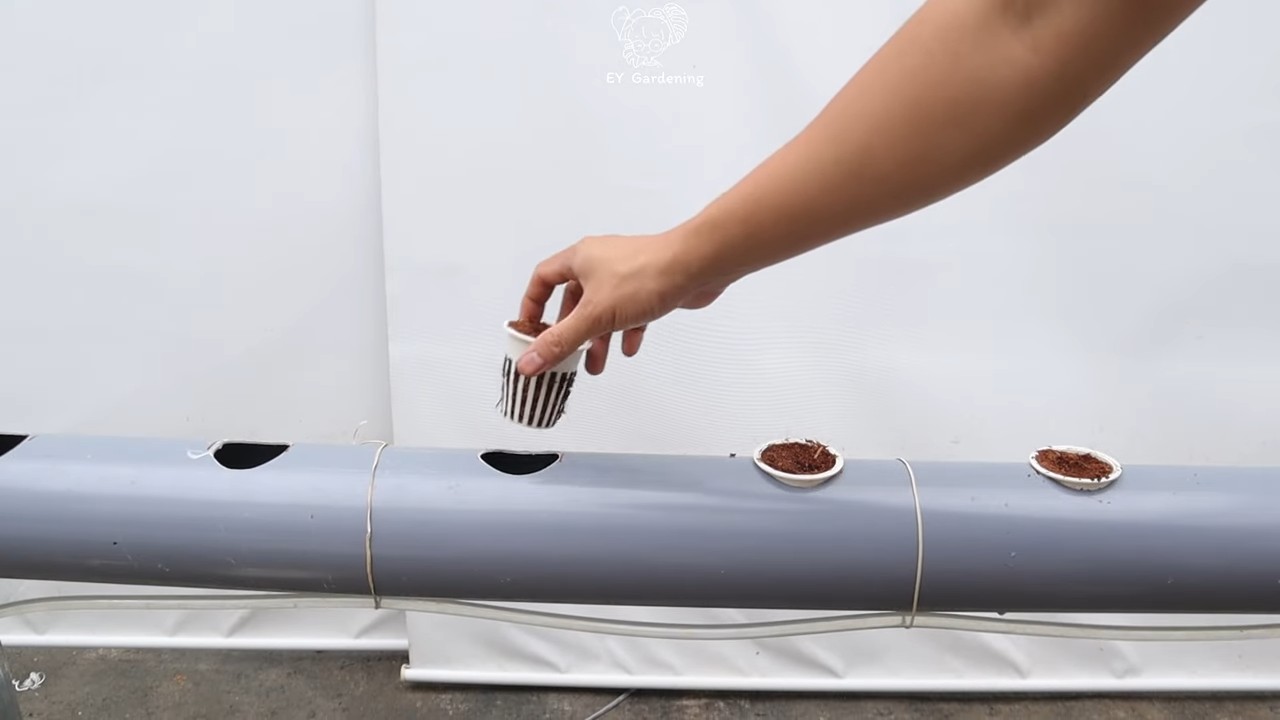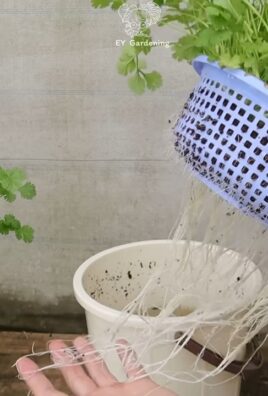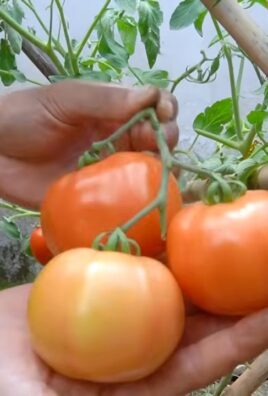Growing cucumbers in water might sound like something out of a futuristic sci-fi film, but trust me, it’s a surprisingly simple and rewarding way to cultivate these crisp, refreshing veggies right in your own home! Forget sprawling gardens and endless weeding; we’re diving into a world where a simple jar of water can become a cucumber-producing powerhouse.
Hydroponics, the art of growing plants without soil, has roots stretching back to ancient civilizations, from the Hanging Gardens of Babylon to the floating gardens of the Aztecs. While those methods were far more complex, the core principle remains the same: providing plants with the nutrients they need directly through water. Now, we’re bringing that concept to your kitchen counter!
Why should you try growing cucumbers in water? Well, for starters, it’s incredibly space-saving, perfect for apartment dwellers or anyone with limited outdoor space. Plus, it eliminates the need for soil, which means no more messy dirt tracked through the house and fewer pests to contend with. But perhaps the biggest draw is the sheer satisfaction of watching a cucumber plant thrive in nothing but water and a little bit of love. I’m excited to show you how to get started with this easy and fun project!

Growing Cucumbers in Water: A Fun and Easy DIY Project
Hey there, fellow gardening enthusiasts! Ever thought about growing cucumbers without soil? It sounds a bit crazy, right? But trust me, it’s totally doable and a super fun experiment. I’m going to walk you through how to grow cucumbers in water, a method that’s surprisingly simple and rewarding. Get ready to ditch the dirt and dive into the world of hydroponic cucumber growing!
What You’ll Need
Before we get started, let’s gather our supplies. Here’s what you’ll need to make this project a success:
* Cucumber Seeds: Choose a variety that’s suitable for container gardening. Bush or compact varieties tend to do best. I personally love the “Spacemaster” or “Bush Champion” varieties.
* Net Pots: These are small, plastic pots with holes in them. They’ll hold your cucumber seedling and allow the roots to access the water.
* Growing Medium: You’ll need something to support the seedling in the net pot. Coco coir, perlite, or rockwool are all excellent choices. I prefer coco coir because it’s sustainable and holds moisture well.
* A Container: This will hold the water and the net pot. A bucket, a large plastic tub, or even a repurposed storage container will work. Just make sure it’s clean and opaque to prevent algae growth.
* Nutrient Solution: Since the cucumbers won’t be getting nutrients from the soil, you’ll need to provide them with a hydroponic nutrient solution. Look for one specifically formulated for fruiting vegetables.
* Air Pump and Air Stone: This is crucial for oxygenating the water, which is essential for healthy root growth.
* pH Meter and pH Up/Down: Maintaining the correct pH level is vital for nutrient absorption.
* Grow Lights (Optional): If you don’t have a sunny spot, you’ll need grow lights to provide adequate light for your cucumbers.
* Rockwool cubes or Seedling Starter Plugs: For germinating your seeds.
* Measuring Cups and Spoons: For accurately mixing your nutrient solution.
* Water: Tap water is fine, but let it sit for 24 hours to allow chlorine to evaporate.
Germinating Your Cucumber Seeds
The first step is to germinate your cucumber seeds. I’ve found that using rockwool cubes or seedling starter plugs works best for this.
1. Soak the Rockwool Cubes/Seedling Plugs: Submerge the cubes or plugs in water for a few minutes until they’re fully saturated. Gently squeeze out any excess water.
2. Plant the Seeds: Make a small hole in the center of each cube or plug and place one or two cucumber seeds in each. Cover lightly with a bit of the rockwool or plug material.
3. Create a Humid Environment: Place the cubes or plugs in a tray or container with a lid to create a humid environment. This will help the seeds germinate.
4. Provide Warmth: Keep the tray in a warm location, ideally around 75-85°F (24-29°C). A heat mat can be helpful if your home is cool.
5. Wait for Germination: Check the cubes or plugs daily and keep them moist. Cucumber seeds typically germinate in 3-7 days. Once the seedlings emerge, remove the lid and provide them with light.
Setting Up Your Hydroponic System
Now that you have seedlings, it’s time to set up your hydroponic system.
1. Prepare the Container: Clean your container thoroughly with soap and water. Rinse it well to remove any soap residue.
2. Drill Holes (If Necessary): If your container doesn’t have a lid, you’ll need to drill holes in the top to accommodate the net pots. Make sure the holes are slightly smaller than the diameter of the net pots so they fit snugly. If you are using a lid, drill holes in the lid.
3. Place the Net Pots: Insert the net pots into the holes.
4. Add the Growing Medium: Fill the net pots with your chosen growing medium (coco coir, perlite, or rockwool).
5. Prepare the Nutrient Solution: Follow the instructions on your nutrient solution to mix it properly. Use a measuring cup and spoon to ensure accurate measurements.
6. Fill the Container: Pour the nutrient solution into the container, leaving a few inches of space at the top. The bottom of the net pots should be submerged in the nutrient solution.
7. Install the Air Pump and Air Stone: Place the air stone at the bottom of the container and connect it to the air pump with tubing. Plug in the air pump to provide oxygen to the roots.
8. Check the pH: Use a pH meter to check the pH of the nutrient solution. The ideal pH for cucumbers is between 5.5 and 6.5. Adjust the pH as needed using pH up or pH down solutions.
Transplanting Your Seedlings
Once your seedlings have a few true leaves, they’re ready to be transplanted into the hydroponic system.
1. Gently Remove the Seedlings: Carefully remove the seedlings from the rockwool cubes or seedling plugs. Be gentle to avoid damaging the roots.
2. Place the Seedlings in the Net Pots: Place each seedling in a net pot filled with your chosen growing medium. Make sure the roots are in contact with the nutrient solution.
3. Add More Growing Medium (If Needed): Add more growing medium around the seedling to provide support.
Caring for Your Hydroponic Cucumbers
Now that your cucumbers are in their new home, it’s important to provide them with the care they need to thrive.
1. Light: Cucumbers need plenty of light, at least 6-8 hours per day. If you don’t have a sunny spot, use grow lights to supplement the natural light.
2. Nutrient Solution: Monitor the nutrient solution regularly and replenish it as needed. Change the solution completely every 1-2 weeks to prevent nutrient buildup.
3. pH: Check the pH of the nutrient solution regularly and adjust it as needed to maintain a pH between 5.5 and 6.5.
4. Water Level: Make sure the water level in the container is high enough to reach the roots of the cucumbers.
5. Temperature: Cucumbers prefer warm temperatures, between 70-80°F (21-27°C).
6. Air Circulation: Good air circulation is important to prevent fungal diseases. A small fan can help improve air circulation.
7. Pollination: Cucumber plants need to be pollinated to produce fruit. If you’re growing your cucumbers indoors, you’ll need to hand-pollinate them. Use a small paintbrush to transfer pollen from the male flowers to the female flowers. Female flowers have a small cucumber behind the flower, while male flowers do not.
8. Support: As your cucumber plants grow, they’ll need support. Provide them with a trellis or stakes to climb on.
9. Pruning: Prune your cucumber plants regularly to encourage fruit production. Remove any yellowing or dead leaves. You can also pinch off the tips of the vines to encourage branching.
Harvesting Your Cucumbers
After a few weeks, you should start to see cucumbers forming. Harvest them when they’re the desired size and color. Simply cut them off the vine with a sharp knife or scissors.
Troubleshooting
Even with the best care, you may encounter some problems while growing cucumbers in water. Here are some common issues and how to address them:
* Yellowing Leaves: This could be a sign of nutrient deficiency. Make sure you’re using a balanced nutrient solution and that the pH is within the correct range.
* Slow Growth: This could be due to insufficient light, low temperatures, or nutrient deficiencies. Make sure your cucumbers are getting enough light and warmth, and that you’re providing them with the nutrients they need.
* Root Rot: This is caused by overwatering or poor aeration. Make sure your air pump is working properly and that the roots are not sitting in stagnant water.
* Pests: Cucumbers can be susceptible to pests like aphids and spider mites. Inspect your plants regularly and treat any infestations promptly with insecticidal soap or neem oil.
Final Thoughts
Growing cucumbers in water is a rewarding and educational experience. It’s a great way to learn about hydroponics and to enjoy fresh, homegrown cucumbers even if you don’t have a garden. With a little bit of care and attention, you can successfully grow cucumbers in water and impress your friends and family with your gardening skills. Happy growing!

Conclusion
So, there you have it! Growing cucumbers in water isn’t just a quirky experiment; it’s a genuinely viable and rewarding method for enjoying fresh, homegrown cucumbers, even without a sprawling garden. We’ve explored the simplicity of the setup, the benefits of soilless cultivation, and the joy of watching your cucumber vines thrive in a clear glass of water.
But why is this DIY trick a must-try? Firstly, it’s incredibly accessible. You don’t need specialized equipment or a green thumb to get started. A simple glass jar, some water, and a cucumber cutting are all you need to embark on this horticultural adventure. Secondly, it’s a fantastic space-saver. Perfect for apartment dwellers, balcony gardeners, or anyone with limited outdoor space, growing cucumbers in water allows you to enjoy fresh produce without sacrificing precious real estate. Thirdly, it’s a fascinating learning experience. Observing the root development and plant growth firsthand provides a unique insight into the wonders of nature.
Beyond the basic method, there’s plenty of room for experimentation and personalization. Consider adding a diluted hydroponic nutrient solution to the water to provide your cucumbers with an extra boost of essential minerals. You can also try different varieties of cucumbers to see which ones thrive best in a water-based environment. Bush varieties, known for their compact growth habit, are often a great choice for this method. You could even explore training your cucumber vines up a small trellis or support structure to maximize space and encourage healthy growth.
Don’t be afraid to get creative with your setup! Use decorative jars or containers to add a touch of style to your indoor garden. Experiment with different lighting conditions to find the optimal environment for your cucumbers. And most importantly, don’t be discouraged if you encounter a few bumps along the road. Gardening is a learning process, and every challenge is an opportunity to grow (pun intended!).
We wholeheartedly encourage you to give this DIY trick a try. It’s a fun, easy, and rewarding way to enjoy fresh, homegrown cucumbers, regardless of your gardening experience or available space. Imagine the satisfaction of harvesting your own crisp, juicy cucumbers from a plant you nurtured in a simple glass of water!
Once you’ve embarked on your water-grown cucumber journey, we’d love to hear about your experience. Share your photos, tips, and challenges in the comments below. Let’s create a community of water-cucumber enthusiasts and learn from each other’s successes and failures. Together, we can unlock the full potential of this innovative and accessible gardening technique. So, grab a cucumber cutting, fill a jar with water, and get ready to experience the magic of growing cucumbers in water! You’ll be amazed at what you can achieve with a little bit of water, sunshine, and a whole lot of enthusiasm. This method of **growing cucumbers in water** is truly a game changer.
FAQ
Can I grow any type of cucumber in water?
While many cucumber varieties can be grown in water, some are better suited than others. Bush varieties, such as Spacemaster or Bush Champion, are generally recommended due to their compact growth habit. These varieties tend to be less demanding in terms of space and support compared to vining varieties. However, with proper support and pruning, you can also successfully grow vining cucumbers in water. Experimenting with different varieties is a great way to discover which ones thrive best in your specific environment. Remember to provide adequate support for vining varieties to prevent them from becoming too heavy and potentially damaging the roots.
What kind of water should I use?
The best type of water to use for growing cucumbers in water is clean, filtered water. Tap water can be used, but it’s best to let it sit for 24 hours to allow chlorine and other chemicals to dissipate. Avoid using softened water, as it contains high levels of sodium, which can be harmful to plants. Rainwater is an excellent option if you have access to it, as it’s naturally soft and free of chemicals. Regardless of the water source, it’s important to change the water regularly, ideally every 1-2 weeks, to prevent the buildup of algae and bacteria.
Do I need to add nutrients to the water?
While cucumbers can initially grow in plain water, they will eventually require nutrients to thrive and produce a good yield. Adding a diluted hydroponic nutrient solution to the water is highly recommended. Look for a balanced nutrient solution specifically formulated for vegetables or leafy greens. Follow the instructions on the nutrient solution label carefully to avoid over-fertilizing, which can damage the plants. Start with a lower concentration of nutrients and gradually increase it as the plants grow. Regular water changes are still necessary, even when using nutrient solutions.
How much sunlight do cucumbers grown in water need?
Cucumbers need plenty of sunlight to grow and produce fruit. Aim for at least 6-8 hours of direct sunlight per day. If you don’t have access to enough natural sunlight, you can supplement with grow lights. Place the grow lights close to the plants, but not so close that they burn the leaves. Rotate the plants regularly to ensure that all sides receive adequate light. Insufficient sunlight can lead to leggy growth, reduced fruit production, and overall poor plant health.
How often should I change the water?
Changing the water regularly is crucial for maintaining the health of your cucumbers grown in water. Aim to change the water every 1-2 weeks, or more frequently if the water becomes cloudy or develops an odor. When changing the water, gently rinse the roots to remove any debris or algae. Be careful not to damage the roots during the process. Fresh water provides the plants with oxygen and helps to prevent the buildup of harmful bacteria and algae.
How do I support the cucumber vines?
As cucumber vines grow, they will need support to climb and prevent them from sprawling on the ground. You can use a variety of support structures, such as a trellis, a stake, or even a simple string. Attach the vines to the support structure using soft plant ties or clips. Prune the vines regularly to encourage branching and fruit production. Removing suckers (small shoots that grow between the main stem and the leaves) can also help to improve airflow and prevent disease.
How long does it take to grow cucumbers in water?
The time it takes to grow cucumbers in water can vary depending on several factors, including the variety of cucumber, the amount of sunlight, and the nutrient levels in the water. Generally, you can expect to harvest your first cucumbers within 60-70 days of planting. However, some varieties may mature faster than others. Providing optimal growing conditions, such as plenty of sunlight, adequate nutrients, and regular water changes, can help to speed up the process.
What are some common problems when growing cucumbers in water?
Some common problems that you may encounter when growing cucumbers in water include algae growth, root rot, and nutrient deficiencies. Algae growth can be prevented by changing the water regularly and keeping the container out of direct sunlight. Root rot can be caused by overwatering or poor drainage. Ensure that the roots have access to oxygen and avoid letting them sit in stagnant water. Nutrient deficiencies can be addressed by adding a diluted hydroponic nutrient solution to the water. Monitor your plants closely for any signs of problems and take action promptly to prevent them from escalating.
Can I grow cucumbers in water year-round?
Yes, you can grow cucumbers in water year-round, especially if you have access to grow lights. With proper lighting and temperature control, you can create an indoor environment that is conducive to cucumber growth, regardless of the season. However, keep in mind that cucumbers typically require warmer temperatures to thrive, so you may need to provide supplemental heating during the colder months. Growing cucumbers in water indoors is a great way to enjoy fresh, homegrown produce even when the weather outside is not ideal.




Leave a Comment